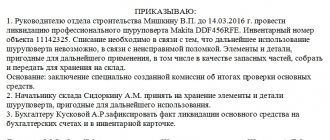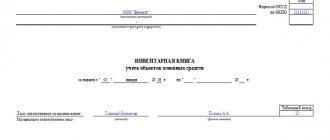Receipt of fixed assets: account 08
In accounting for the receipt of fixed assets, the unchangeable rule that applies to any version of the receipt of fixed assets is the accumulation of the initial cost in the debit of the account. 08. It is from this that, on the date of putting the object into operation, the resulting price of the asset is written off by posting D/t 01 K/t 08. Until this moment, the initial cost is formed by transferring costs from various accounts. The receipt of fixed assets in the company is carried out:
- For a fee;
- Free of charge;
- Contribution to the authorized capital of the enterprise.
Let's look at each option in more detail.
Registration of receipt of fixed assets for a fee
The price of an asset purchased under a purchase and sale agreement is made up of the company’s actual costs directly for the acquisition (manufacturing), transportation and bringing the asset to a normal condition for operation. It also includes amounts paid to contractors and consultants, non-refundable and customs fees/duties, and fees to intermediaries.
When purchasing an OS, the initial cost is “collected” in the debit of the account. 08 from credit accounts 60, 76, etc.
Example 1
The company purchased the machine for 360,000 rubles, incl. VAT 20% – 60,000 rub. Delivery of the machine cost the company 30,000 rubles. excluding VAT, and installation and commissioning costs 12,000 rubles. without VAT. The accountant completed the purchase with the following entries:
Operations D/t K/t Sum Purchased a machine 08 60 300 000 VAT included 19 60 60 000 Costs taken into account: — on transportation 08 76 30 000 - on commissioning and commissioning 08 76 12 000 VAT is accepted for deduction 68 19 60 000 The machine was put into operation (300,000 + 30,000 + 12,000) 01 08 342 000
In the same way, the cost of an object constructed (manufactured) on its own is formed - using an economic method. In addition to settlement accounts, the formation of the price of an asset will also include costs associated with its creation, for example, materials, personnel salaries, deductions, wear and tear of equipment used in the formation of new property, etc. – D/t 08 K/t 02, 10, 23, 69, 70. When constructing an investment asset, its value may include interest on long-term and short-term loans – D/t 08 K/t 66.67.
Purchase of fixed assets
If your organization purchased fixed assets for a fee (under a purchase and sale or supply agreement), determine their initial cost as the sum of all costs associated with this purchase.
Such costs, for example, could be:
- amounts paid to the seller in accordance with the agreement;
- amounts paid for delivery and installation;
- amounts paid for information and consulting services related to the acquisition of this fixed asset;
- customs duties and fees;
- non-refundable taxes, state duties paid in connection with the acquisition of fixed assets;
- interest on loans and borrowings received for the acquisition of fixed assets, if it is an investment asset;
- other costs directly related to the acquisition of fixed assets.
You must first take into account the costs of acquiring fixed assets in the debit of account 08 “Investments in non-current assets” (without value added tax):
DEBIT 08 CREDIT 60 (76, …)
– costs directly related to the acquisition of fixed assets are taken into account (excluding VAT);
then, based on the invoices, reflect the amount of value added tax:
DEBIT 19 CREDIT 60 (76, …)
– VAT is taken into account on costs directly related to the acquisition of fixed assets.
After the fixed asset item is put into operation, make an entry to the debit of account 01:
DEBIT 01 CREDIT 08
– a fixed asset facility was put into operation.
Then report the value added tax deduction:
DEBIT 68 subaccount “VAT calculations” CREDIT 19
– tax deduction has been made.
There are situations when a property requires state registration, but is already in use.
Until 2011, such objects could be accounted for in two ways: on account 08 “Investments in non-current assets” or on a separate sub-account opened to account 01 “Fixed Assets”.
Starting from 2011, temporarily operated real estate should be accounted for as part of fixed assets (with allocation in a separate sub-account).
The fact of submitting documents for state registration does not matter (clause 52 of the Guidelines for accounting of fixed assets, approved by order No. 91n dated October 13, 2003).
Depreciation on such fixed assets must be calculated in the usual manner: from the 1st day of the month following the month the property was accepted for accounting (letter of the Federal Tax Service of the Russian Federation dated August 29, 2011 No. ZN-4-11 / [email protected] ).
The fact of filing documents for state registration of ownership for the calculation of depreciation does not matter.
PRIMERAO Aktiv acquired a warehouse building under a sale and purchase agreement.
According to the agreement, the cost of the warehouse is 1,180,000 rubles. (including VAT - 180,000 rubles). 15,000 rubles were paid for the state registration of the building. The Aktiva accountant must make the following entries: DEBIT 60 CREDIT 51
– 1,180,000 rubles.
– the seller’s invoice has been paid; DEBIT 08 CREDIT 60
– 1,000,000 rub.
– the building is capitalized on the organization’s balance sheet (excluding VAT); DEBIT 19 CREDIT 60
– 180,000 rub.
– the amount of VAT according to the seller’s invoice is taken into account; DEBIT 01 subaccount “Fixed assets that are subject to state registration” CREDIT 08
– 1,000,000 rubles.
– the building is accounted for in a separate subaccount; DEBIT 68 subaccount “Calculations for VAT” CREDIT 19
– 180,000 rub.
– tax deduction has been made. After the building is ready for commissioning, the Aktiva accountant must make the following entries: DEBIT 01 CREDIT 01 subaccount “Fixed assets that are subject to state registration”
- 1,000,000 rubles.
– the building is included in fixed assets. Since state registration now takes place after the property is accepted for registration, it is impossible to take into account the costs of paying the state duty in its original cost. The amount of costs for paying the state duty must be taken into account as part of current expenses: DEBIT 76 CREDIT 51
– 15 000 rub.
– money was transferred to pay for state registration of ownership of the building; DEBIT 26 CREDIT 68 subaccount “State duty”
– 15,000 rubles. – the amount of state duty for registering ownership of the building is taken into account.
If you use real estate objects that are reflected in your account 08 (not transferred to fixed assets in time) for the production of products, provision of services or for management needs, then property tax must be charged on such objects (Definition of the Supreme Arbitration Court of the Russian Federation dated 25 March 2013 No. BAS-3043/13).
Let us recall that in accordance with paragraph 6 of PBU 6/01, the accounting unit of fixed assets is an inventory item. An inventory item of fixed assets is an object with all its fixtures and accessories, or a separate structurally isolated item intended to perform certain independent functions, or a separate complex of structurally articulated items that constitute a single whole and are intended to perform a specific job. A complex of structurally articulated objects is one or more objects of the same or different purposes, having common devices and accessories, common control, mounted on the same foundation, as a result of which each object included in the complex can perform its functions only as part of the complex, and not independently.
Let's consider how a company can record the purchase of a personal computer in its accounting.
PRIMERAO Aktiv acquired a personal computer under a purchase and sale agreement. The invoice indicated the cost of the computer components:
- system unit – RUB 33,040. (including VAT – 5040 rub.);
- monitor – 13,570 rub. (including VAT – 2070 rub.);
- keyboard – 1180 rub. (including VAT - 180 rubles);
- mouse – 590 rub. (including VAT - 90 rubles).
Total: the cost of the computer is 48,380 rubles. (including VAT - 7380 rubles).
The components of a computer (system unit, monitor, keyboard, mouse) can only function as part of a single complex, so the Aktiva accountant accepted them for accounting as a single inventory object and made the following entries:
DEBIT 60 CREDIT 51
– 48,380 rub. – the seller’s invoice has been paid;
DEBIT 08 CREDIT 60
– 41,000 rub. (48 380 – 7380) – the computer was capitalized on the organization’s balance sheet (at the cost of its components excluding VAT);
DEBIT 19 CREDIT 60
– 7380 rub. – the amount of VAT according to the seller’s invoice is taken into account.
“Aktiv” additionally paid for the delivery of the computer (236 rubles, including VAT – 36 rubles) in cash from the cash register through an accountable person:
DEBIT 71 CREDIT 50
– 236 rub. – money was given from the cash register to the accountable person to pay for the delivery of the computer; v
DEBIT 08 CREDIT 71
– 200 rub. (236 – 36) – the delivery fee is taken into account in the book value of the computer (based on the advance report of the accountable person);
DEBIT 19 CREDIT 71
– 36 rub. – VAT is taken into account on delivery costs (based on the invoice of the transport organization).
When the computer was put into operation, the Aktiva accountant made the following entries:
DEBIT 01 CREDIT 08
– 41,200 rub. (41,000 + 200) – the computer is included in the organization’s fixed assets;
DEBIT 68 subaccount “VAT calculations” CREDIT 19
– 7416 rub. (7380 + 36) – tax deduction has been made.
In exchange for goods, Aktiv receives a laptop from Passive LLC.
The Aktiva accountant made the following entries:
DEBIT 45 CREDIT 41
– 35,000 rub. – the cost of goods shipped under a goods exchange agreement is written off;
DEBIT 08 CREDIT 60
– 43,000 rub. – a laptop received under a commodity exchange agreement was capitalized.
After this, the Aktiva accountant must reflect the proceeds from the sale of the goods and write off its cost. For the procedure for recording these transactions, see standard situations “How to reflect revenue under a commodity exchange (barter) agreement” to account 90 “Sales”.
If the market price of the transferred property cannot be determined, then determine the value of the received fixed assets based on the prices at which the organization acquires similar fixed assets.
Accounting for the receipt of fixed assets when contributing to the management company
When receiving OS as a contribution to the company's management company, its value is established by an independent appraiser and agreed upon by the founders. The rule applies here: inviting a specialist to evaluate an object included in the Criminal Code, a property contribution, is mandatory. Such receipt of fixed assets is recorded in accounting by entry D/t 08 K/t 75.
For your information! When receiving property as a contribution to the management company from a company that pays VAT, the recipient has the right to a refund of the VAT charged to him, which was previously restored.
Example 2
LLC received equipment as a contribution to its management company. Its estimate is 200,000 rubles. The amount of VAT previously recovered by the participant and presented to the company is 36,000 rubles. The postings to the receiving company will be as follows:
Operations D/t K/t Sum OS received as a contribution to the management company 08 75 200 000 VAT included 19 83 36 000 VAT refunded 68 19 36 000 The equipment is included in the OS 01 08 200 000
Free receipt of fixed assets: postings
The initial value of an asset donated (usually on the basis of a gift agreement) is recognized as its market price on the date of acceptance for accounting on the account. 08 from credit account 98. Subsequently, deferred income is written off when depreciation is charged on other income.
Example 3
The company received the asset free of charge. Its current cost was 400,000 rubles, its service life was 40 months. Postings:
Operations D/t K/t Sum Received object 08 98 400 000 OS taken into account 01 08 400 000 Monthly depreciation (400,000 / 40 months) 20 02 10 000 Depreciation accrued for the month is recognized as income for the current period. 98 91/1 10 000
Receipt of OS during construction
During construction, assets are taken into account at a price consisting of all expenses for the purchase of materials, transportation and contract work.
The receipt of OS in this way is reflected by the following transactions:
- D08 – K60, 76 – accounting for the price of the contractor’s work;
- D08 – K10 – accounting of materials that were transferred to the contractor for the construction of an environmental facility;
- D08 – K60, 76, 23, 25, 26 – accounting for other costs that are associated with the construction of the facility;
- D19 - K60, 76, 23, 25, 26 - allocation of VAT on costs associated with the construction of the facility;
- D01 – K08 – introduction of an OS object into use.
After the object has been put into use, you need to start charging depreciation on it.
Similar articles
- Accounting for lease of fixed assets
- Acceptance of fixed assets for accounting
- Fixed Asset Accounting
- Fixed assets: postings
- Account 01 “Fixed assets”
Capitalization of an unaccounted fixed asset object
It happens that when conducting an inventory of property, unaccounted for objects are identified. Often these are structures (for example, various overpasses, overhead towers, etc.) manufactured in the company’s workshops and used in production, but not taken into account as part of the enterprise’s operating system due to various circumstances.
The initial cost of such objects is determined as the market value at the time of capitalization, and is taken into account using the other income account:
Operations D TO Unaccounted assets identified 08 91/1 Entering an object into the OS 01 08
Stage 2. Formation of the initial cost of the object
Fixed assets are taken into account in the initial valuation. Its size depends on the method of receipt of property into the organization and the costs associated with this receipt (delivery, storage, etc.).
In accordance with the Chart of Accounts for accounting financial and economic activities of organizations and instructions for its application, approved by Order of the Ministry of Finance of the Russian Federation dated October 31, 2000 No. 94n (hereinafter referred to as the Chart of Accounts), all actual costs associated with the receipt of fixed assets and forming it the initial cost is reflected in synthetic account 08 “Investments in non-current assets”. The following subaccounts can be opened for this account:
- 08-1 “Acquisition of land”,
- 08-2 “Purchase of environmental management facilities”,
- 08-3 “Construction of fixed assets”,
- 08-4 “Acquisition of fixed assets”,
- 08-5 “Acquisition of intangible assets”,
- 08-6 “Transfer of young animals to the main herd”,
- 08-7 “Acquisition of adult animals”,
- 08-8 “Performing research, development and technological work”, etc.
Account 08 is active. The debit of account 08 reflects the actual costs of the organization, which are included in the initial cost of the fixed asset item. The generated initial value is written off from the credit of account 08 to the debit of account 01 “Fixed Assets” or 03 “Income Investments in Material Assets” (if the assets are intended to be provided for a fee for temporary possession and use or temporary use). In this case, the following entry is made in accounting:
Debit 01 – Credit 08 – reflects the acceptance of the object for accounting as a fixed asset at its original cost.
The debit balance of account 08 shows the amount of the organization's investments in construction in progress, unfinished operations for the acquisition of fixed assets.
Analytical accounting for account 08 is carried out in the context of costs associated with the acquisition, construction or production of fixed assets, separately for each object.
Important to remember. The organization does not have the right to keep an item of movable property on account 08 if there is no need to carry out additional work to bring it to a condition suitable for use. Consequently, assets for which the initial cost has been formed and which are completely ready for operation are included in fixed assets in accounting, regardless of whether they are used by the organization or not.
This position is supported by the Ministry of Finance of the Russian Federation in its letters (dated 06/09/2009 No. 03-05-05-01/31, dated 04/18/2007 No. 03-05-06-01/33, dated 09/06/2006 No. 03-06-01-02/35), and its correctness is confirmed by arbitration practice (Resolution of the FAS of the East Siberian District dated 06/04/2009 No. A33-11961/08-F02-2387/09).
Example 1 . In December 2014, the organization purchased office furniture suitable for use. Its actual operation began only in March 2015, when a lease agreement for office space was signed. In this situation, you should not adhere to the logic that the acquired property cannot be used, and keep it on account 08 until March 2015. Office furniture must be accepted for accounting on account 01 in December 2014.
If an organization does not transfer an object to fixed assets for quite a long time, it must document its decision (this may be due to the need for additional capital investments). The main reason that an object “hangs” on account 08 may be the lack of necessary parts (components, structures, etc.), as a result of which the received asset cannot be used.
Example 2 . In January 2015, the organization purchased a used cement concrete plant from an individual. The design was missing an important detail, without which the facility could not be put into operation. The part was purchased and installed only in May 2015. In this situation, the organization has every reason to hold the object on account 08 until May.
Note. The rules for accepting an asset for accounting as a fixed asset are somewhat different from those established by the Tax Code. This may lead to the fact that the start dates for depreciation in different types of accounting will not coincide.
In tax accounting, the fact of direct use of an object is a necessary condition for its inclusion in depreciable property (Clause 1 of Article 256 of the Tax Code of the Russian Federation). In addition, according to clause 4 of Article 259 of the Tax Code of the Russian Federation, the moment of commissioning serves as the starting point for calculating depreciation.
In accounting, in order for an asset to begin to depreciate, it is enough to take it into account on account 01 (clause 21 of PBU 6/01). The actual use does not matter. It is important that the facility is ready for use.
If we apply these conclusions to the situation described in example 1, the organization will begin to depreciate office furniture:
- in accounting - from the 1st day of the month following the month the object was accepted for accounting (clause 21 of PBU 6/01), i.e. from January 1, 2015;
- in tax accounting - from the 1st day of the month following the month the facility was put into operation (clause 4 of Article 259 of the Tax Code of the Russian Federation), i.e. from April 1, 2015







